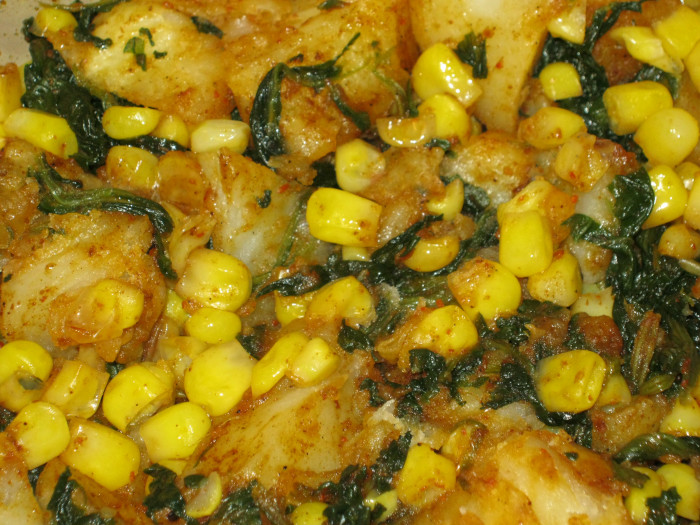Microwave Vegetable GuideEd Grochowski Written 5-24-2019Updated 9-1-2019 
Spicy Microwaved Vegetables with Corn, Potatoes, Spinach, Olive Oil,
and Chili Powder
IntroductionThe microwave oven is perhaps the most useful cooking appliance ever invented for the vegetarian. The microwave excels at cooking vegetables in very little time with minimal clean-up required afterwards. Microwave cooking differs in techniques from conventional cooking. This article explains how to cook a variety of vegetables in the microwave. EquipmentAlong with the microwave oven, one needs suitable containers and potholders or dish towels. Containers for microwave cooking should have loosely fitting covers to let steam escape. They should be made from materials that do not block microwaves (i.e. no metal). The best containers are made from ceramic with glass lids. These are sold under the brand name CorningWare. Also good are glass bowls with plastic lids sold under the brand name Pyrex. Containers should be large enough to accommodate the vegetables, but not several times larger. While plastic containers are useful for food storage, they are poorly suited for microwave cooking since plastic chemicals may leach into hot foods. Similarly, hot foods eventually will discolor plastic containers. Plastic containers will do if nothing else is available. PreparationFresh VegetablesFresh vegetables should be peeled, sliced, and rinsed. Slices should be similar in size with thicknesses of 1cm or less.
Frozen VegetablesFrozen vegetables should be rinsed prior to microwaving. Frozen vegetables require somewhat longer cooking times because they first must thaw. GrainsGrains can be prepared in the microwave by adding a suitable amount of water. CookingAll food placed in the microwave should be wet. This is because the microwave heats water, both outside and inside the vegetables. Microwave cooking is steaming. Cook the vegetables in a container with a loosely fitting cover. If the microwave has a variable power setting, set it to 100%. Cooking times depend on the quantity of food and the microwave's power output. Small amounts of vegetables typically cook in 3-5 minutes; medium amounts in 5-7 minutes; and large amounts in 8-12 minutes. One can see the steam escaping and smell food. Vegetables will not be fully cooked by the time the microwave turns off. Let the vegetables sit, covered, for a few minutes. Cooking completes using residual heat. Different types of vegetables can be cooked together as long as the pieces are not too different in size. I regularly cook entire meals in one container. Excess water from certain vegetables (eggplant, zucchini) should be drained. Grains should be brought to a boil on full power, and then some grains require additional simmering at 20% power. Couscous and oatmeal require only boiling (about 3 minutes on my microwave). Rice requires additional simmering (another 7-14 minutes). Cooking should be monitored to prevent boil-over. SeasoningAt this point, one has a bowl of steamed vegetables. The last step is to add oil and seasonings. Oils are selected based on flavor rather than ability to withstand high temperatures. I like to drizzle extra-virgin olive oil over vegetables. Alternatively, I use unrefined coconut oil if I want a heavier dish. Any seasonings can be used. I like chili powder, hot sauce, garlic, and soy sauce. These turn bland microwaved vegetables into spicy microwaved vegetables. Just add and stir. Dinner is now ready, often in under 10 minutes. SafetyIn my experience, cooking with a microwave oven poses far fewer safety risks than cooking over a stove. Microwaves are electromagnetic waves like radio waves and visible light. They are present inside the oven only during cooking. The door's perforated metal screen is transparent to visible light (wavelength 0.5um) but opaque to microwaves (wavelength 12cm). When the oven turns off, no microwave energy remains. Food cooked in the microwave will be steaming hot. Use a potholder or utensil to carefully lift the lid. ConclusionWith proper techniques, the microwave oven can do much more than reheat leftovers. I do most of my cooking in the microwave. I consider the microwave to be essential for the vegetarian. |